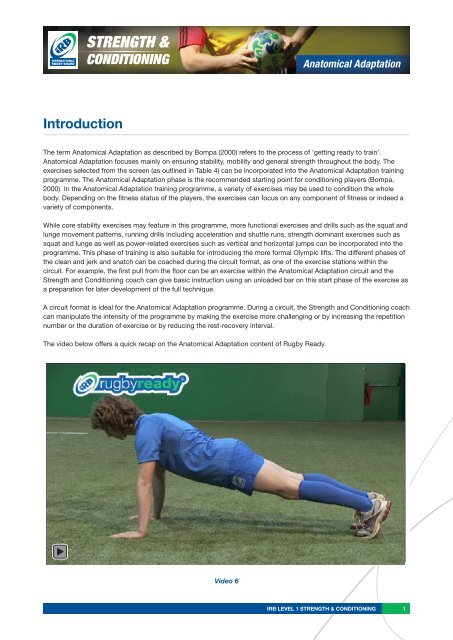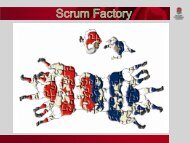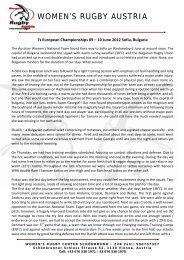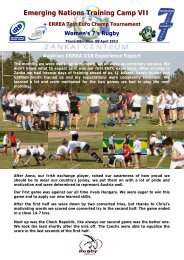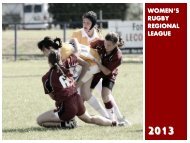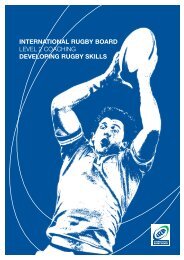Anatomical Adaptation - womensrugby.at
Anatomical Adaptation - womensrugby.at
Anatomical Adaptation - womensrugby.at
- No tags were found...
You also want an ePaper? Increase the reach of your titles
YUMPU automatically turns print PDFs into web optimized ePapers that Google loves.
STRENGTH &CONDITIONING<strong>An<strong>at</strong>omical</strong> <strong>Adapt<strong>at</strong>ion</strong>IntroductionThe term <strong>An<strong>at</strong>omical</strong> <strong>Adapt<strong>at</strong>ion</strong> as described by Bompa (2000) refers to the process of ‘getting ready to train’.<strong>An<strong>at</strong>omical</strong> <strong>Adapt<strong>at</strong>ion</strong> focuses mainly on ensuring stability, mobility and general strength throughout the body. Theexercises selected from the screen (as outlined in Table 4) can be incorpor<strong>at</strong>ed into the <strong>An<strong>at</strong>omical</strong> <strong>Adapt<strong>at</strong>ion</strong> trainingprogramme. The <strong>An<strong>at</strong>omical</strong> <strong>Adapt<strong>at</strong>ion</strong> phase is the recommended starting point for conditioning players (Bompa,2000). In the <strong>An<strong>at</strong>omical</strong> <strong>Adapt<strong>at</strong>ion</strong> training programme, a variety of exercises may be used to condition the wholebody. Depending on the fitness st<strong>at</strong>us of the players, the exercises can focus on any component of fitness or indeed avariety of components.While core stability exercises may fe<strong>at</strong>ure in this programme, more functional exercises and drills such as the squ<strong>at</strong> andlunge movement p<strong>at</strong>terns, running drills including acceler<strong>at</strong>ion and shuttle runs, strength dominant exercises such assqu<strong>at</strong> and lunge as well as power-rel<strong>at</strong>ed exercises such as vertical and horizontal jumps can be incorpor<strong>at</strong>ed into theprogramme. This phase of training is also suitable for introducing the more formal Olympic lifts. The different phases ofthe clean and jerk and sn<strong>at</strong>ch can be coached during the circuit form<strong>at</strong>, as one of the exercise st<strong>at</strong>ions within thecircuit. For example, the first pull from the floor can be an exercise within the <strong>An<strong>at</strong>omical</strong> <strong>Adapt<strong>at</strong>ion</strong> circuit and theStrength and Conditioning coach can give basic instruction using an unloaded bar on this start phase of the exercise asa prepar<strong>at</strong>ion for l<strong>at</strong>er development of the full technique.A circuit form<strong>at</strong> is ideal for the <strong>An<strong>at</strong>omical</strong> <strong>Adapt<strong>at</strong>ion</strong> programme. During a circuit, the Strength and Conditioning coachcan manipul<strong>at</strong>e the intensity of the programme by making the exercise more challenging or by increasing the repetitionnumber or the dur<strong>at</strong>ion of exercise or by reducing the rest-recovery interval.The video below offers a quick recap on the <strong>An<strong>at</strong>omical</strong> <strong>Adapt<strong>at</strong>ion</strong> content of Rugby Ready.Video 6IRB LEVEL 1 STRENGTH & CONDITIONING1
STRENGTH &CONDITIONING<strong>An<strong>at</strong>omical</strong> <strong>Adapt<strong>at</strong>ion</strong>Acute training variablesThe Strength and Conditioning coach can apply the acute training variables to manage the workload during eachtraining unit or session. The acute training variables include:• Frequency - the number of training units in a week• Intensity - the effort of the exercise• Time - the dur<strong>at</strong>ion of exercise (or repetitions) prescribed• Type - the choice and order of exerciseDepending on the stage of development of the players and the opportunity for training, the Strength and Conditioningcoach may complete such a programme 1-3 times a week.The repetitions used within any exercise in a circuit may vary but typically may be medium to high (from 6-15repetitions) and can combine body weight, medicine balls, pulleys, tubing, Swiss balls, dumbbells, broom handles orany other props or equipment th<strong>at</strong> will gradually provide an overload or gre<strong>at</strong>er resistance challenge to the player. Thegoal is to set a found<strong>at</strong>ion of general strength, stability, mobility and good movement skills during the <strong>An<strong>at</strong>omical</strong><strong>Adapt<strong>at</strong>ion</strong> phase. Our sample routine minimises the use of exercise equipment. However, the Strength andConditioning coach is encouraged to use a much wider range of exercises including external loaded exercises (but notusing near maximum or maximum external loads). The choice will ultim<strong>at</strong>ely depend on the equipment available as wellas the fitness st<strong>at</strong>us of the player.Benefits of the <strong>An<strong>at</strong>omical</strong> <strong>Adapt<strong>at</strong>ion</strong> phaseIt has been shown th<strong>at</strong> when players add an individualised conditioning programme th<strong>at</strong> takes account of the individualplayer’s physical needs in addition to their team skill and practice training th<strong>at</strong> gre<strong>at</strong>er gains in terms of fitness occur(Andrzejewski et al, 2011, Rhea et al, 2009, Gilligan et al, 2005). As st<strong>at</strong>ed earlier, <strong>An<strong>at</strong>omical</strong> <strong>Adapt<strong>at</strong>ion</strong> exercises anddrills can be manipul<strong>at</strong>ed to suit the needs of the players.The benefits of completing a varied, needs-rel<strong>at</strong>ed training programme such as an <strong>An<strong>at</strong>omical</strong> <strong>Adapt<strong>at</strong>ion</strong> phase oftraining include:• A reduced risk of injury• Gre<strong>at</strong>er stability development• Improved range of motion or flexibility development• Better movement mechanics• Enhanced strength, power and speed• Better found<strong>at</strong>ion for l<strong>at</strong>er strength training(Andrzejewski et al, 2011, Rhea et al, 2009, Gilligan et al, 2005, Bompa, 2000)IRB LEVEL 1 STRENGTH & CONDITIONING2
STRENGTH &CONDITIONING<strong>An<strong>at</strong>omical</strong> <strong>Adapt<strong>at</strong>ion</strong>A sample <strong>An<strong>at</strong>omical</strong> <strong>Adapt<strong>at</strong>ion</strong> circuitThe exercises listed below can be organised indoors or outdoors. The sample circuit can be completed by severalplayers for 2-3 circuits with each exercise taking 20 to 60 seconds dur<strong>at</strong>ion, depending on the level of fitness of theplayer. Additionally, the rest recovery between exercises can be on a 1:2 r<strong>at</strong>io (i.e. 30 seconds work and 60 secondsrecovery and getting ready) during the early stages of the programme. This work/rest r<strong>at</strong>io can move towards a 1:1 r<strong>at</strong>ioas the players advance in their general fitness. The rest between the circuits is dict<strong>at</strong>ed by the level of fitness of theplayers. However, as a starting place, a 2-minute interval can be prescribed before the next circuit.A sample <strong>An<strong>at</strong>omical</strong> <strong>Adapt<strong>at</strong>ion</strong> circuit addressing key stability positions and movement p<strong>at</strong>terns is as follows:• Bridge• Hurdle hop• Lunge to T-stance• Wall squ<strong>at</strong>• IYTW• Press-up• Rolling p<strong>at</strong>tern• Speed marching drill• Partner pull-up• Vertical jump with squ<strong>at</strong> thrustOther exercises can be used depending on the level of fitness of the players, their individual needs based on anOverhead Squ<strong>at</strong> Functional Screen and based on the facilities and equipment available. The Strength and Conditioningcoach can be cre<strong>at</strong>ive in this.IRB LEVEL 1 STRENGTH & CONDITIONING4
STRENGTH &CONDITIONING<strong>An<strong>at</strong>omical</strong> <strong>Adapt<strong>at</strong>ion</strong>Exercise detailsBridgeKey factors:Video 7• From lying on the back, lift the body off the ground with heels and feet in contact and the upper back in contactwith the ground.• Keep a strong and stable body from shoulder to the knee.• Maintain a braced core throughout the exercise.• Note the video clip shows the player moving onto the heels during the bridge for gre<strong>at</strong>er gluteal activ<strong>at</strong>ion.IRB LEVEL 1 STRENGTH & CONDITIONING5
STRENGTH &CONDITIONING<strong>An<strong>at</strong>omical</strong> <strong>Adapt<strong>at</strong>ion</strong>Hurdle hopIRB LEVEL 1 STRENGTH & CONDITIONING6
STRENGTH &CONDITIONING<strong>An<strong>at</strong>omical</strong> <strong>Adapt<strong>at</strong>ion</strong>Key factors:Video 8• Place a series of small hurdles in line (2-6 hurdles to start).• From a single leg stance, hop vertically and over the hurdle.• Cushion landing by flexing <strong>at</strong> knee.• Ensure alignment between knee and foot upon landing.• Note in the video clip, the player is hopping to the side in the drill.IRB LEVEL 1 STRENGTH & CONDITIONING7
STRENGTH &CONDITIONING<strong>An<strong>at</strong>omical</strong> <strong>Adapt<strong>at</strong>ion</strong>Lunge to T-stanceKey factors:Video 9• Move into a lunge.• Balancing on the lead leg, move into ‘T-stance’ position.• Maintain alignment of knee and foot.• Slightly flex knee for gre<strong>at</strong>er balance.IRB LEVEL 1 STRENGTH & CONDITIONING8
STRENGTH &CONDITIONING<strong>An<strong>at</strong>omical</strong> <strong>Adapt<strong>at</strong>ion</strong>Wall squ<strong>at</strong>Key factors:Video 10• Standing approxim<strong>at</strong>ely 30cm from the wall with arms raised (holding a ball).• Adjust feet position to allow deep squ<strong>at</strong> (toes slightly rot<strong>at</strong>ed outwards and feet slightly wider than shoulderwidth).• Descend into deep squ<strong>at</strong>. Maintain an upright torso and neutral low back throughout the exercise.IRB LEVEL 1 STRENGTH & CONDITIONING9
STRENGTH &CONDITIONING<strong>An<strong>at</strong>omical</strong> <strong>Adapt<strong>at</strong>ion</strong>IYTWIRB LEVEL 1 STRENGTH & CONDITIONING10
STRENGTH &CONDITIONING<strong>An<strong>at</strong>omical</strong> <strong>Adapt<strong>at</strong>ion</strong>Key factors:Video 11• Keep shoulder blades in a neutral position.• Squeeze muscles between shoulder blades.• Hold the contraction for a count of three.IRB LEVEL 1 STRENGTH & CONDITIONING11
STRENGTH &CONDITIONING<strong>An<strong>at</strong>omical</strong> <strong>Adapt<strong>at</strong>ion</strong>Press-upVideo 12IRB LEVEL 1 STRENGTH & CONDITIONING12
STRENGTH &CONDITIONING<strong>An<strong>at</strong>omical</strong> <strong>Adapt<strong>at</strong>ion</strong>Key factors:Video 13• Brace the core.• Maintain a strong and stable body from ankles to head.• Place hands <strong>at</strong> slightly wider than shoulder width.• Note th<strong>at</strong> Video 13 displays player moving body while completing press-ups.IRB LEVEL 1 STRENGTH & CONDITIONING13
STRENGTH &CONDITIONING<strong>An<strong>at</strong>omical</strong> <strong>Adapt<strong>at</strong>ion</strong>Rolling p<strong>at</strong>ternIRB LEVEL 1 STRENGTH & CONDITIONING14
STRENGTH &CONDITIONING<strong>An<strong>at</strong>omical</strong> <strong>Adapt<strong>at</strong>ion</strong>Video 14Video 15IRB LEVEL 1 STRENGTH & CONDITIONING15
STRENGTH &CONDITIONING<strong>An<strong>at</strong>omical</strong> <strong>Adapt<strong>at</strong>ion</strong>Key factors:• Lie prone (face down) with arms overhead (see Video 14).• Flex knee and then extend hip to rot<strong>at</strong>e onto back.• Ensure stretched, long body position when rolling.• Lie supine (face up) with arms overhead (see Video 15).• Flex knee and hip and then cross-flex knee over body, pushing leg straight.• Rot<strong>at</strong>e to prone position.IRB LEVEL 1 STRENGTH & CONDITIONING16
STRENGTH &CONDITIONING<strong>An<strong>at</strong>omical</strong> <strong>Adapt<strong>at</strong>ion</strong>Speed marching drillKey factors:Video 16• Stand on one leg in sprint posture.• Maintain good balance throughout.• Switch lead knee and arms quickly.IRB LEVEL 1 STRENGTH & CONDITIONING17
STRENGTH &CONDITIONING<strong>An<strong>at</strong>omical</strong> <strong>Adapt<strong>at</strong>ion</strong>Partner pull-upKey factors:Video 17• Partner players according to equal body weight.• Player A lies down on back with arms extended up and out.• Player B assumes a strong squ<strong>at</strong> position.• Player B must have a strong neutral back.• Player A grasps Player B <strong>at</strong> the forearms.• Player B tucks elbows into body.• Player A performs a pull-up with a rigid body.IRB LEVEL 1 STRENGTH & CONDITIONING18
STRENGTH &CONDITIONING<strong>An<strong>at</strong>omical</strong> <strong>Adapt<strong>at</strong>ion</strong>Vertical jump with squ<strong>at</strong> thrustKey factors:Video 18• From a standing position, the player drops to a squ<strong>at</strong> thrust position.• The player then jumps vertically.• Cushion landing by flexing <strong>at</strong> knee and hip upon landing.• Avoid landing on heels first.IRB LEVEL 1 STRENGTH & CONDITIONING19
STRENGTH &CONDITIONING<strong>An<strong>at</strong>omical</strong> <strong>Adapt<strong>at</strong>ion</strong>Module summaryThis module emphasised the need for the coach to understand the key principles of the Long Term Player Developmentp<strong>at</strong>hway. This module provides guidelines to the Strength and Conditioning coach and indeed the club or school inplanning the prepar<strong>at</strong>ion programme for the player. The module provides a series of stages th<strong>at</strong> track the developmentalneeds of the player from childhood (Fundamental stage) through to a series of stages to adulthood.In addition, the coach is recommended to observe and note the physical needs of his players. Using a simple OverheadSqu<strong>at</strong> movement p<strong>at</strong>tern, individual imbalances th<strong>at</strong> may exist within this common movement p<strong>at</strong>tern can be identified.The screen is a convenient and simple method of helping the coach to prescribe the found<strong>at</strong>ion conditioning th<strong>at</strong> willmeet the players’ needs. We described a phase of conditioning known as ‘<strong>An<strong>at</strong>omical</strong> <strong>Adapt<strong>at</strong>ion</strong>’ which is intended toprepare the player for more intense and challenging training and practice routines. This programme can be varied andcan address both individual player limit<strong>at</strong>ions and general fitness components such as strength, power and speed andacceler<strong>at</strong>ion, as well as mobility and game-rel<strong>at</strong>ed drills and activities.In our next module, we will examine the demands of the game and from this we will have a clearer overview of thephysical challenges th<strong>at</strong> the player encounters during m<strong>at</strong>ch play. This then leads us to a more relevant prescription ofthe type and methods of conditioning th<strong>at</strong> can be used to better prepare our players for the game of Rugby.IRB LEVEL 1 STRENGTH & CONDITIONING20


